Hi All,
I came across an article in audio express which states that bleeder resistor is not needed in a "pi" filter in the power supply section. Can anybody shed some light on this, since I am not able to understand what author meant. I always assumed that bleeder resistor is necessary to discharge high voltages in tube rectifier circuits.
The audio express link is: The 2A3 Tube Amplifier - A Tribute to Simplicity and Warm Sound | audioXpress
Thanks and Regards,
Shan
I came across an article in audio express which states that bleeder resistor is not needed in a "pi" filter in the power supply section. Can anybody shed some light on this, since I am not able to understand what author meant. I always assumed that bleeder resistor is necessary to discharge high voltages in tube rectifier circuits.
The audio express link is: The 2A3 Tube Amplifier - A Tribute to Simplicity and Warm Sound | audioXpress
Thanks and Regards,
Shan
Hi All,
I came across an article in audio express which states that bleeder resistor is not needed in a "pi" filter in the power supply section. Can anybody shed some light on this, since I am not able to understand what author meant. I always assumed that bleeder resistor is necessary to discharge high voltages in tube rectifier circuits.
The audio express link is: The 2A3 Tube Amplifier - A Tribute to Simplicity and Warm Sound | audioXpress
Thanks and Regards,
Shan
This design violates the conditions for the GZ34, maximum size of first cap
is 60uF. See https://frank.pocnet.net/sheets/010/g/GZ34.pdf
It doesn't need a bleeder resistor because it t is a class A amplifier which is always conducting, not because it has a pi filter, and the article doesn't actually say otherwise. It says this design uses a pi-filter with no need for a bleeder resistor, but it doesn't link the two in a causation chain.
As I see it, thank you for correctly pointing out that the resistor path is the only permanent one.the amplifier needs a heavy bleed to work.
It doesn't need a bleeder resistor because it t is a class A amplifier which is always conducting
Class A tube amps still benefit from a bleeder resistor.
Surviving spouses benefit from the lack of a bleeder resistor.
They get an inheritance.
Use a bleeder resistor and stay alive.
Calculate the time for discharge to a safe voltage (or remove the bottom plate very slowly, and check the voltage with a voltmeter before digging in).
Just imagine your amplifier 'dies' and you open it up.
Ahh, it was a dead output tube(s), and so the B+ still has high voltage, because you forgot to use a bleeder resistor.
Ouch!
Safety First!
They get an inheritance.
Use a bleeder resistor and stay alive.
Calculate the time for discharge to a safe voltage (or remove the bottom plate very slowly, and check the voltage with a voltmeter before digging in).
Just imagine your amplifier 'dies' and you open it up.
Ahh, it was a dead output tube(s), and so the B+ still has high voltage, because you forgot to use a bleeder resistor.
Ouch!
Safety First!
Not if the output device is faulty or missing. Always have bleeder for safety.It doesn't need a bleeder resistor because it t is a class A amplifier which is always conducting
Just imagine your amplifier 'dies' and you open it up.
Ahh, it was a dead output tube(s), and so the B+ still has high voltage, because you forgot to use a bleeder resistor.
Ouch!
Safety First!
That is a good and very important point. Thanks and will connect a bleeder to my amp power supply.
I calculated it, 1.3 Meg Ohms to discharge 400uF will take a lot longer than
1 minute per screw on a 6 screw bottom plate.
In fact, the RxC time constant is 520 seconds (8.66 minutes).
In 520 seconds, the Bleeder will discharge B+ from 300V down to 109V.
A dead 6P3P may cause harm to anybody getting inside before 15 minutes of discharge time.
Remember, Safety First.
Repeat after me,
Surviving Spouse Syndrome
1 minute per screw on a 6 screw bottom plate.
In fact, the RxC time constant is 520 seconds (8.66 minutes).
In 520 seconds, the Bleeder will discharge B+ from 300V down to 109V.
A dead 6P3P may cause harm to anybody getting inside before 15 minutes of discharge time.
Remember, Safety First.
Repeat after me,
Surviving Spouse Syndrome
Last edited:
- Home
- Amplifiers
- Tubes / Valves
- Bleeder resistor not needed for "pi" filter?

